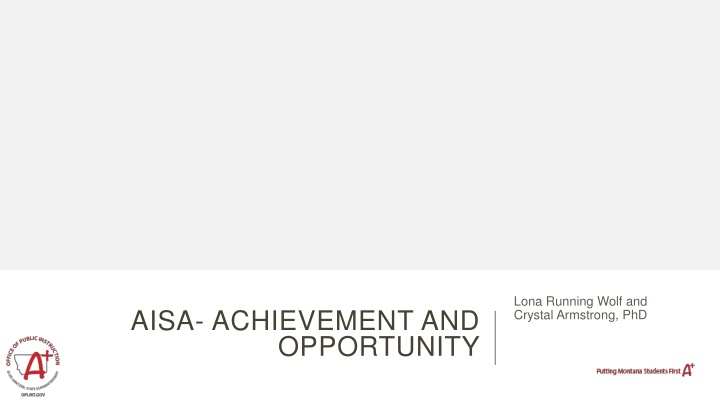
Factors Influencing American Indian Student Achievement Gap in Montana Schools
Explore the factors influencing the American Indian student achievement gap in Montana schools and communities through insightful research. Discover stakeholders' perspectives, impact areas, and solutions for narrowing the gap.
Download Presentation

Please find below an Image/Link to download the presentation.
The content on the website is provided AS IS for your information and personal use only. It may not be sold, licensed, or shared on other websites without obtaining consent from the author. If you encounter any issues during the download, it is possible that the publisher has removed the file from their server.
You are allowed to download the files provided on this website for personal or commercial use, subject to the condition that they are used lawfully. All files are the property of their respective owners.
The content on the website is provided AS IS for your information and personal use only. It may not be sold, licensed, or shared on other websites without obtaining consent from the author.
E N D
Presentation Transcript
Lona Running Wolf and Crystal Armstrong, PhD AISA- ACHIEVEMENT AND OPPORTUNITY
RESEARCH QUESTION In Montana schools and communities, what factors influence the American Indian student achievement gap? Which factors do education stakeholders believe are the driving factors in the achievement gap? Do those factors vary for students who attend school on-reservation versus those who attend off-reservation? Where do education stakeholders believe impact can be made to close the achievement gap?
METHODS 10 Focus groups- 42 total participants from 15 different communities On and off-reservation participation Purposive sampling- regional, role, size factors Zoom focus groups Questions about achievement gap, on/off reservation differences, student perceptions, and imagining without barriers Transcribed and organized into 1799 total comments, comprised of 78 topics Grouped into 15 themes within 5 overarching categories
CATEGORIES Frequency 780 Culture and the Family 539 Pedagogy, Curriculum, and Instruction 441 School System 709 Student Learning 409 Trauma and Student Identity Total 2878
MAIN TAKEAWAYS Participant comments indicated a 40/60 split in perceptions about the achievement gap. 40 percent of comments pertained to factors out the school- community, family, geography, and other external things. 60 percent of comments were internal to the school experience. In schools, the importance of Indian educators cannot be downplayed. They are mentors, role models, and increase curricula relevance. Students need to see teachers who look like them. Implicit/explicit bias from educators continues to be noticed by students. Stakeholders also called for revisiting the role of the school counselor and ways to promote social emotional learning. Personalized learning: stakeholders see a need to make learning relevant, adaptable, and self-paced. This includes an increased focus on CTE, alternative education programs, or alternative graduation requirements. They also call for examining perceptions about achievement (incl. social promotion) and attendance- which are cited frequently in the dataset in relation to dropout
MAIN TAKEAWAYS CONTINUED Trauma is interwoven throughout the dataset both generational trauma originating inside the home and historical trauma. Participants advocated strongly for programs and training targeting trauma, acknowledgement of the impacts of trauma, and genuine efforts to acknowledge historical trauma connected to education. When students see their culture thriving, positive identity, well-being, and achievement are more readily formed and supported. Estrangement from culture may impact drop out. Few cultural ties to testing also lead to a student disconnect with assessments. Helping students develop an identity that is built of a sense of belonging to community and culture improves student well-being. Feelings of student alienation and hopelessness are barriers to positive identity formation- impacting this well-being
NEXT STEPS Large scale survey Representation from roles, regions, and sizes Feedback prior to execution Consultation with Indigenous scholars on findings Full technical report (incl. methodology) and condensed discussion of findings available at http://opi.mt.gov/Leadership/Data-Reporting/Research- Portal#9965311336-culture--schools-american-indian-perspectives-on-the-american-indian- student-achievement-gap For questions on the focus groups, methods, or findings, please contact: Lona Running Wolf at Lona.RunningWolf@mt.gov or Nicole Frieling at Nicole.Frieling@mt.gov
